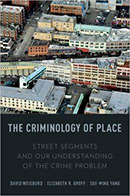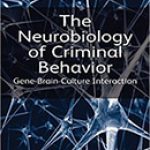The Criminology of Place: Street Segments and Our
Understanding of the Crime Problem

Authors: David Weisburd, Elizabeth Groff, and Sue-Ming Yang
Publisher: Oxford, UK; New York: Oxford University Press, 2013. 288p.
Reviewer: Anthony A. Braga | March 2013
The empirical observation that a small number of micro places generate the bulk of urban crime problems has become a criminological axiom. These micro places, commonly referred to as “hot spots” of crime, have been defined as clusters of street addresses, groupings of street blocks, and collections of particular street intersections and street segments. High-activity crime places have been found in neighborhoods characterized by both low and high levels of social disadvantage. More recently, researchers have examined whether the concentration of crime at particular places is stable over time. The stability of crime at hot spots reinforces the logic that underlies place-based prevention strategies. Without intervention, crime hot spots are not likely to disappear in short time periods. Concentrating crime prevention resources on such places makes good sense both for short term and long term gains.
In The Criminology of Place: Street Segments and Our Understanding of the Crime Problem, criminologists David Weisburd, Elizabeth Groff, and Sue-Ming Yang provide the fullest account to date on how very small places powerfully influence levels of crime across urban landscapes and, more importantly, make concrete suggestions on what society should be doing to address these persistently problematic locations. For most of the last century, criminologists have generally focused on understanding why particular individuals become involved in criminal activity or why particular neighborhoods experienced elevated levels of crime. Academic interest in the criminology of a place developed from research suggesting that micro-level variation in crime existed within communities and the attributes of specific places were important in understanding the concentration of crime at particular locations. Weisburd, Groff, and Yang draw upon existing criminological theory and synthesize new theoretical insights to show that crime is powerfully coupled with specific small places.
Beyond summarizing the available theoretical and empirical evidence, The Criminology of Place presents new research findings from an ongoing longitudinal study of crime in Seattle, Washington. Weisburd, Groff, and Yang use street segments (defined as the “block faces between two intersections”) as the units of geographic analysis in their examination of the variation in crime across small places. Looking at crime incidents at street segments in Seattle over a sixteen year period, Weisburd, Groff, and Yang find that, year to year, about 50 percent of the crime was found in approximately 5 to 6 percent of street segments. More than 80 percent of the street segments experienced no or very little crime during the study time period. Using a recently developed technique for identifying crime trends over time, they grouped the approximately 30,000 street segments in Seattle into “trajectories” with similar developmental trends over time. Only about one percent fell in the high-crime trajectory group, but these street segments consistently accounted for more than 20 percent of reported crime during the study time period.
Importantly, Weisburd, Groff, and Yang find noteworthy street-to-street variability in the crime patterns in the Seattle data. This variability is empirically linked to the nature of criminal opportunities at these specific places. By comparing high-crime street segments to generally crime-free street segments, the authors report that larger residential populations and higher numbers of employees are more likely to be found on high-crime street segments. They suggest that increased numbers of people on the street translate into an increased volume of targets for criminals. The authors also find that arterial roads dramatically increase the risks of crime on street segments. Arterial roads are easily accessible and suggested to increase the likelihood that motivated offenders and suitable crime targets will converge in space and time.
Explanations for the persistence of high-crime places have traditionally drawn upon routine activity theory (one variety of opportunity theory) which suggests that the routine activities of offenders, victims and what have sometimes been termed guardians contribute to the likelihood of crime occurring in particular places. Less often noted as potential explanatory factors are the physical features of these places. These are emphasized in other varieties of opportunity theory including crime pattern theory and situational prevention. To take high crime street segments as an example, these latter theories would emphasize such factors as (1) the type of street (e.g., commercial or residential, variations in land use), (2) the presence of “criminogenic facilities” (bars and taverns, betting shops, check cashing businesses, pawn shops, porn shops, liquor stores, gun stores, late-night fast food outlets), (3) signs of disorder (drug market, teen hang-out prostitution stroll, graffiti, abandoned vehicles, abandoned buildings, litter) and (4) other generators of street activity (e.g. bus routes/stops, parking lots, and street lighting). The authors include many, but not all, of these factors in their analyses of the role of criminal opportunities in generating higher levels of crime at specific street segments.
Weisburd, Groff, and Yang develop a new perspective on the street-to-street variability in crime patterns. They suggest that collective efficacy, usually defined as “social cohesion among neighbors combined with their willingness to intervene on behalf of the common good,” could also be a powerful explanation for the uneven distribution of crime within neighborhoods. In their analyses, indicators of social disorganization (measured as the value of residential property and the amount of housing assistance) are significantly related to the level of crime at particular street segments. Crime hot spots are much less likely at places with wealthier residents. Voter participation on the street segment is used as a more direct measure of collective efficacy in specific places. Contrasting street segments with no active voters to street segments where all registered voters are active voters, the authors find that the more involved residents are in public affairs, the less likely the street segments are to have chronic crime problems. Perhaps the most important single finding in The Criminology of Place is that both opportunity and social disorganization perspectives matter in understanding crime at place and, taken together, these factors permit a stronger way to predict spatial and temporal variations in crime.
The general policy implications drawn from other investigations of crime and place are that crime hot spots are good targets for scarce crime prevention resources and these interventions should be tailored to address the place dynamics, situations, and characteristics that cause a “spot” to be “hot.” Most discussions of place-oriented crime prevention focus on what police, place managers, and others can do to manage recurring problems in crime hot spots. Weisburd, Groff, and Yang concur with these perspectives and then advance this line of reasoning by encouraging policy makers, practitioners, and scholars to recognize a broader range of risk and protective factors at high-crime places. The authors rightly note that the concentration of crime at micro places provides an important opportunity to “lower the scale” of social and structural interventions designed to mobilize community leaders, increase social cohesion, and enhance economic investments. The authors suggest that refocusing these types of crime prevention initiatives on specific places, rather than diffusing resources across larger geographic areas, could improve their effectiveness.
The Criminology of Place represents an important advance in our understanding of the nature of urban crime problems. It is very well written and comprehensive in its coverage of relevant empirical and theoretical criminological research. The book also presents new data on and empirical analyses of the nature of crime problems at places. The visually-striking color maps and graphs provide clear and easy-to-understand summaries of the authors’ key research findings and arguments. This book is a must read for city managers, politicians, police executives, community leaders, and others interested in dealing with urban crime problems in a more effective way.
Anthony A. Braga is the Don M. Gottfredson Professor of Evidence-Based Criminology in the School of Criminal Justice at Rutgers University and a Senior Research Fellow in the Program in Criminal Justice Policy and Management at Harvard University.


